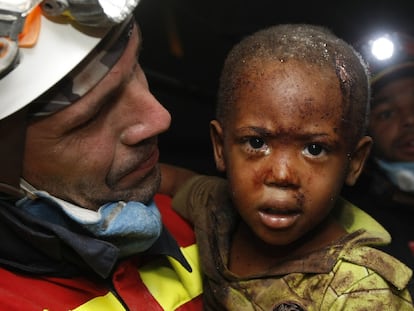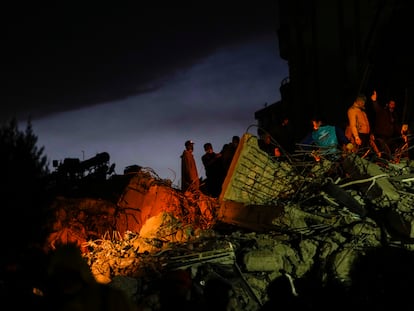Aid workers pour into Turkey in effort to reach survivors at epicenter of earthquake
International teams are being deployed in the hardest-hit areas of the country but face delays in reaching survivors due to the scale of destruction and fuel shortages

Overnight on Tuesday, the 14 men under the command of Ramón Pérez Ibáñez had landed at Istanbul Airport and knew their destination, but without a clear roadmap. Less than 24 hours later, Pérez Ibáñez tells EL PAÍS by telephone that his team were working in the rubble of a completely destroyed building in Adiyaman, 160 kilometers (100 miles) from the epicenter of the magnitude 7.8 earthquake that struck Turkey and Syria on Monday, creating a horizontal gallery to try to get a trapped man out alive. “We’re not moving from here until we get him out,” said the head of the Emergency and Disaster Rescue Unit of the Valencia Provincial Fire Department.
Pérez Ibáñez and his team are operational and participating in rescue efforts alongside hundreds of other firefighters and specialized personnel who have arrived in Turkey over the last 48 hours, via the humanitarian corridor opened by Ankara.
The procedure for international rescue teams is roughly as follows: the emergency personnel volunteering to help with the massive search and rescue effort first contact the Turkish Embassy in their country of origin and from there they are redirected to the Disaster and Emergency Management Authority (AFAD), an agency of the Interior Ministry in Ankara. When the teams arrive on Turkish soil, AFAD is responsible for distributing them to the regions in the southeast of the country where the earthquake struck. This is what is known in humanitarian jargon as the coordination “cell,” under which state cooperation agencies and NGOs are organized, and which in this case has set up its operational headquarters in the province of Hatay.

This was the procedure that deployed a second group of Spanish firefighters, who also arrived on Tuesday, to Adiyaman. The team traveled from the Spanish city of Zaragoza and consists of seven people: three dog handlers, two health workers and two rescuers, among them the head of the detachment, Enrique Mur. Via this route, the logistics are fairly smooth. The strip of territory hit by the earthquake also contains the Incirlik Air Base, which is used mainly by the Turkish and US Air Forces – providing the main entry point for assistance from the United States Agency for International Development (USAID) – in addition to a small NATO contingent. Incirlik has proven vital for the landing of international emergency teams and provides swift road access to the affected areas.
But without the humanitarian corridor and the explicit cooperation of the Turkish authorities, the journey to the epicenter of the earthquake becomes very difficult. Bureaucratic delays and the obstacles posed by the terrain have left rescuers facing a race against the clock to reach the remaining survivors. The main objective of the major humanitarian organizations is to reach Kahramanmaras, a city of just over one million inhabitants located 79 km (44 miles) from the epicenter of the quake and which was hit by a 7.5-magnitude aftershock following the initial earthquake. Located around 140 km (87 miles) from the Syrian border, on Wednesday – when Turkish President Recep Tayyip Erdoğan visited the area – Kahramanmaras remained cut off from emergency personnel and without electricity or internet access.
However, many of the humanitarian convoys traveling by road through the south of the country – some of which become stranded for hours queuing at gas stations to refuel – are instead aiming to get to the hard-hit city of Gaziantep, the epicenter of the 7.8-magnitude quake, where a coordination point has been set up.

Sub-zero temperatures
EL PAÍS traveled to Adana, a city of 2.2 million inhabitants 500 kilometers (310 miles) south of Ankara, with officials from the EU’s Civil Protection and Humanitarian Aid Operations Department, which is carrying out an assessment mission before deploying their teams. Snow and sub-zero temperatures, together with the destruction caused by the earthquake and fuel shortages, are hampering the arrival of international aid teams. On Turgut Özal Boulevard in the northwest of the city, the foreign presence is virtually non-existent. A row of aid booths has been set up for residents of the buildings that adjoin one of those that collapsed during the earthquake. The majority of the aid organizations on the ground are local, with The Turkish Red Cross providing the lead.
On the other side of the street, where dozens of rescuers are working on top of the mountain of rubble left by the 14-story building that collapsed on Monday, dozens of citizens, aid workers and security forces personnel gather around fires lit on the sidewalk. Many local residents who were forced to evacuate their homes due to the risk of further building collapses, wait at police checkpoints to be told it is safe to return. Gökberk, 20 – who prefers not to give his surname – is one of them. He could go to his parents’ house on the outskirts of the city, but he remains 40 meters away from the cranes. “I have nothing else,” he says, “except to go back inside my house.” Next to him, Halil, 58, watches the rescuers in the hope that they will find the parents of a friend of his son. But things are moving very slowly.
The journey of Borja González de Escalada, vice-president of the Seville-based SAMU emergency medical assistance services foundation, is also proving slow. SAMU is one of the few private Spanish initiatives – in this case with the support of the US-based Project HOPE – which participates in these types of emergencies. González de Escalada on Wednesday traveled with five other aid workers from Ankara to Adana and from there to the east, to Gaziantep, to reach the humanitarian coordination point.
He tells EL PAÍS that after more than 12 hours on the road, they have not yet been “invited” to the NGO cluster, the conglomerate of organizations that coordinates aid workers in the area. González de Escalada is waiting for the green light to provide his assistance and for four other colleagues from a canine search and rescue team, currently stuck in Istanbul, to gain authorization to join his mission.
Sign up for our weekly newsletter to get more English-language news coverage from EL PAÍS USA Edition
Tu suscripción se está usando en otro dispositivo
¿Quieres añadir otro usuario a tu suscripción?
Si continúas leyendo en este dispositivo, no se podrá leer en el otro.
FlechaTu suscripción se está usando en otro dispositivo y solo puedes acceder a EL PAÍS desde un dispositivo a la vez.
Si quieres compartir tu cuenta, cambia tu suscripción a la modalidad Premium, así podrás añadir otro usuario. Cada uno accederá con su propia cuenta de email, lo que os permitirá personalizar vuestra experiencia en EL PAÍS.
¿Tienes una suscripción de empresa? Accede aquí para contratar más cuentas.
En el caso de no saber quién está usando tu cuenta, te recomendamos cambiar tu contraseña aquí.
Si decides continuar compartiendo tu cuenta, este mensaje se mostrará en tu dispositivo y en el de la otra persona que está usando tu cuenta de forma indefinida, afectando a tu experiencia de lectura. Puedes consultar aquí los términos y condiciones de la suscripción digital.
More information
Archived In
Últimas noticias
Most viewed
- Sinaloa Cartel war is taking its toll on Los Chapitos
- Oona Chaplin: ‘I told James Cameron that I was living in a treehouse and starting a permaculture project with a friend’
- Reinhard Genzel, Nobel laureate in physics: ‘One-minute videos will never give you the truth’
- Why the price of coffee has skyrocketed: from Brazilian plantations to specialty coffee houses
- Silver prices are going crazy: This is what’s fueling the rally










































